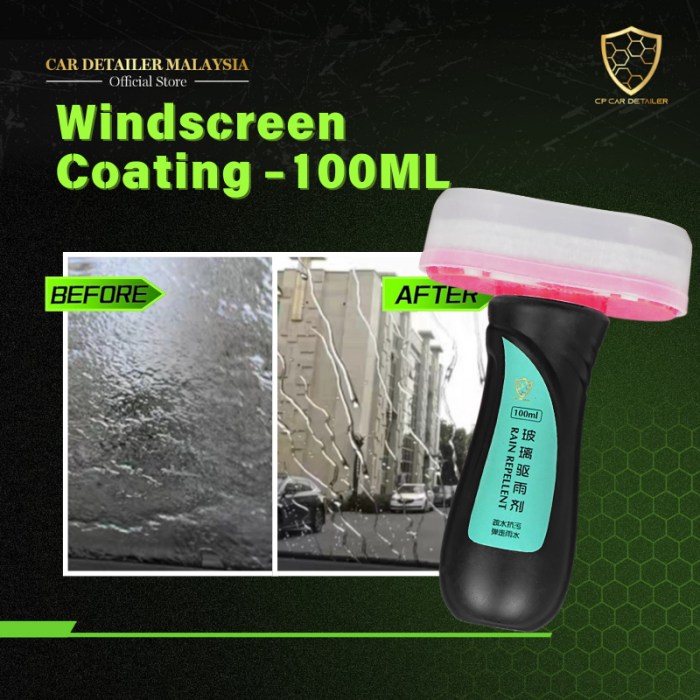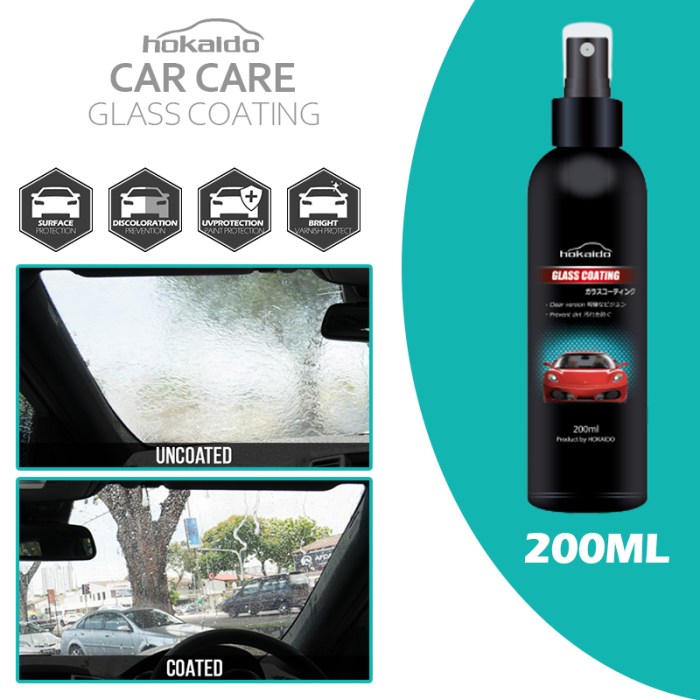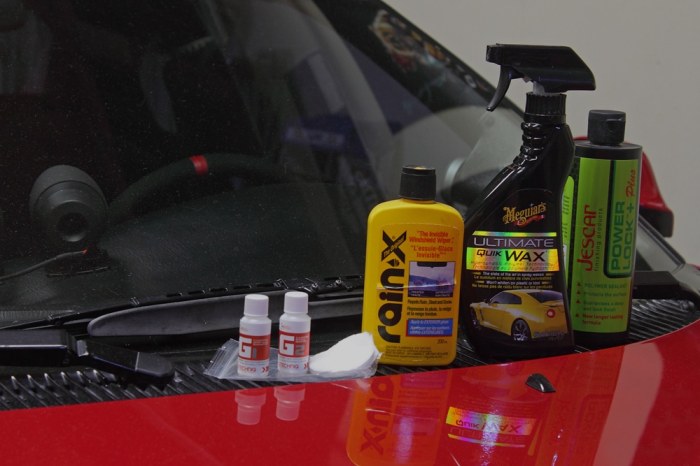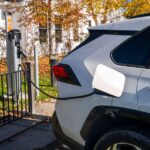Best Rain Repellent Windshield Coatings 2025 – Seriously, driving in the rain sucks. But imagine this: wipers barely needed, crystal-clear vision even in a downpour. That’s the promise of rain repellent windshield coatings. This guide dives deep into the science, the different types, application tips, and the top products hitting the market in 2025, so you can finally ditch those annoying streaks and enjoy a safer, clearer drive.
We’ll break down everything from the chemistry behind how these coatings work to helping you choose the perfect one for your car and your climate. Whether you’re a DIY enthusiast or prefer professional installation, we’ve got you covered. Get ready to say goodbye to blurry vision and hello to a seriously awesome driving experience.
Introduction to Rain Repellent Windshield Coatings

Driving in the rain can be a nerve-wracking experience, especially with reduced visibility. Rain repellent windshield coatings offer a significant upgrade to driver safety and comfort by dramatically improving visibility in wet conditions. These coatings create a hydrophobic surface, causing water to bead up and easily sheet away from the windshield, minimizing the need for constant wiper use and improving overall driving clarity.These coatings work by altering the surface chemistry of the glass.
They create a microscopically textured surface that is extremely water-repellent. This is achieved through the use of various chemical compounds, often silanes or fluoropolymers, which bond to the glass at a molecular level. These compounds possess a strong affinity for the glass and a strong aversion to water. When water droplets land on the treated surface, they maintain a high contact angle (meaning they sit on top of the coating rather than spreading out), reducing surface tension and encouraging the water to bead and roll off quickly.
The result is a significantly clearer view, even at highway speeds in heavy rain.
The Science Behind Rain Repellent Coatings
The effectiveness of rain repellent coatings is directly related to the contact angle of water droplets on the treated surface. A higher contact angle indicates greater hydrophobicity. The specific chemical composition and application method of the coating significantly impact this contact angle. Advanced coatings may utilize nanotechnology to create even more effective repellent surfaces. For example, some coatings incorporate nano-sized silica particles which further enhance the hydrophobic properties and increase durability.
The process of application is also critical; proper cleaning and preparation of the windshield surface are essential for achieving optimal bonding and performance.
A Brief History of Rain Repellent Windshield Coating Technology, Best rain repellent windshield coatings 2025
While the concept of hydrophobic surfaces has been around for a long time, the development of commercially viable rain repellent windshield coatings is a relatively recent phenomenon. Early versions of these coatings were often less durable and required more frequent reapplication. However, advancements in material science and nanotechnology have led to significant improvements in longevity and performance. The introduction of silane-based coatings marked a significant step forward, offering better adhesion and water repellency compared to previous generations.
Today, we see a wide range of products available, each offering varying levels of durability, effectiveness, and ease of application. The evolution continues, with ongoing research focused on creating even more durable, long-lasting, and environmentally friendly formulations.
Types of Rain Repellent Windshield Coatings
Choosing the right rain repellent windshield coating can significantly improve driving safety and visibility, especially in adverse weather conditions. The market offers a variety of options, each with its own strengths and weaknesses regarding application, longevity, and performance. Understanding these differences is key to making an informed decision.
Rain repellent coatings primarily fall into three main categories: ceramic, polymer, and silicone-based. While they all aim to achieve the same result – improved water beading and shedding – their chemical compositions, application processes, and durability vary considerably.
Ceramic Coatings
Ceramic coatings are known for their exceptional durability and hydrophobic properties. They create a hard, glass-like layer on the windshield that repels water incredibly effectively. Application typically involves a multi-step process, starting with thorough cleaning and preparation of the windshield surface. The coating is then applied in thin layers, often requiring multiple coats for optimal performance. After application, a curing period is necessary to allow the coating to fully harden.
High-quality ceramic coatings can last for several years, offering long-term protection and improved visibility. Their higher initial cost is often offset by their extended lifespan.
So, you’re looking for the best rain repellent windshield coatings in 2025? Keeping your windshield clear is key, but let’s be real, a clean car interior is just as important. Check out this guide for Top-rated car vacuum cleaners for pet hair if you’ve got furry friends shedding everywhere. Then, once your car’s spick and span inside and out, you can really appreciate that crystal-clear windshield thanks to those awesome rain repellents!
Polymer Coatings
Polymer coatings provide a balance between performance and cost. They offer good water repellency and are generally easier to apply than ceramic coatings. Application often involves spraying the coating onto the clean windshield and then buffing it to a smooth finish. The longevity of polymer coatings is typically shorter than ceramic coatings, often lasting between six months and two years, depending on the product and application.
However, their relatively lower price and easier application make them a popular choice for those seeking a more budget-friendly option.
Silicone Coatings
Silicone-based coatings are the most common and readily available type of rain repellent. They are often found in spray-on bottles and are relatively easy to apply. The application process usually involves spraying the coating onto a clean windshield and then wiping it clean with a microfiber cloth. Silicone coatings are generally the least durable, with their effectiveness typically lasting only a few months.
While their short lifespan may require more frequent reapplications, their low cost and ease of use make them a convenient option for many drivers.
So, you’re looking into the best rain repellent windshield coatings for 2025? That’s smart, especially if you’re planning on buying a new car – figuring out your monthly payments is key, so check out this awesome car loan calculator with taxes and fees to stay on budget. Once you’ve got your financing sorted, you can focus on getting that crystal-clear windshield for safer driving.
Comparison of Rain Repellent Windshield Coatings
The following table summarizes the key features of four common types of rain repellent coatings. Note that specific performance and longevity can vary based on the brand, application technique, and environmental factors.
| Coating Type | Durability | Application | Cost |
|---|---|---|---|
| High-End Ceramic | 2-5 years | Multi-step, professional application often recommended | High |
| Mid-Range Ceramic | 1-2 years | DIY application possible with careful preparation | Medium-High |
| Polymer | 6 months – 2 years | Spray-on, relatively easy application | Medium |
| Silicone | 1-6 months | Spray-on, very easy application | Low |
Factors to Consider When Choosing a Coating
Choosing the right rain repellent windshield coating can significantly improve your driving safety and convenience. The market offers a wide variety of options, each with its own strengths and weaknesses. To make an informed decision, you need to carefully weigh several crucial factors. This will ensure you get the best bang for your buck and a product perfectly suited to your individual needs.Picking the perfect rain repellent coating involves more than just looking at the price tag.
Consider your driving habits, climate, and vehicle type to ensure the coating you choose offers optimal performance and longevity. A coating that works wonders in a dry climate might not perform as well in areas with heavy rainfall or extreme temperature fluctuations. Similarly, the application process itself can influence your choice, especially if you’re planning a DIY installation.
Price and Value
The cost of rain repellent coatings varies widely, ranging from budget-friendly options to premium, high-performance products. While a higher price often indicates superior performance and durability, it’s essential to consider the overall value proposition. A more expensive coating might be worth the investment if it lasts significantly longer or offers superior water repellency, ultimately saving you money in the long run.
For example, a high-end ceramic coating might cost three times as much as a basic polymer-based option, but its lifespan could be three to five times longer, making it a more cost-effective choice over its lifetime.
Ease of Application
The application process can be a major deciding factor, especially for those who prefer DIY projects. Some coatings are designed for easy application, requiring only a few simple steps, while others demand more technical expertise and precision. Read product reviews carefully to understand the application process and assess your skill level accordingly. If you’re unsure, consider opting for a professional installation, even if it adds to the overall cost.
A poorly applied coating, regardless of its quality, will not perform optimally.
Effectiveness and Durability
The effectiveness of a rain repellent coating is measured by its ability to repel water and improve visibility in wet conditions. Look for coatings with high water repellency ratings and a proven track record. Durability is equally important; a long-lasting coating will save you time and money on reapplications. Consider the manufacturer’s claims about the coating’s lifespan and read independent reviews to verify these claims.
For example, some manufacturers claim their coatings last for a year or more, while others might only offer a few months of protection.
Vehicle Type and Climate
The type of vehicle and the climate you drive in will significantly impact your choice of coating. For instance, a coating designed for cars might not be suitable for motorcycles or trucks, especially if they are frequently exposed to harsh weather conditions. Similarly, a coating that performs well in mild climates might not be as effective in areas with extreme temperatures or heavy rainfall.
Consider the specific challenges posed by your environment when making your selection. A driver in a snowy region might prioritize a coating that withstands freezing temperatures and ice build-up, while a driver in a tropical climate might focus on resistance to intense heat and humidity.
Application and Maintenance of Coatings

Applying a rain repellent windshield coating correctly is crucial for optimal performance and longevity. Improper application can lead to streaking, uneven coverage, and a shorter lifespan for the product. Similarly, neglecting maintenance will diminish the effectiveness of the coating over time. Following the manufacturer’s instructions carefully is paramount, but these general guidelines should provide a helpful framework.
Step-by-Step Application Guide
Thorough preparation is key to a successful application. Begin by thoroughly cleaning your windshield. Use a high-quality glass cleaner and a microfiber cloth to remove any dirt, grime, bugs, or existing waxes. Pay special attention to removing any stubborn residue. Next, ensure the surface is completely dry before proceeding.
Many coatings require a perfectly clean, dry surface for optimal adhesion. After cleaning, apply the coating according to the manufacturer’s instructions, usually involving dispensing a small amount onto a clean applicator pad or cloth and spreading it evenly across the windshield. Allow the coating to cure completely before driving, as specified on the product packaging, typically ranging from a few hours to overnight.
Avoid driving in rain during the curing period.
Maintenance Procedures for Extended Lifespan
Regular washing is the most important maintenance step. Use a gentle car wash soap and a soft sponge or wash mitt to avoid scratching the coating. Avoid abrasive cleaners or scrub brushes. After washing, rinse thoroughly and dry the windshield with a clean, soft microfiber cloth. Inspect your windshield periodically for any signs of wear or reduced repellency.
If the water starts beading less effectively, consider reapplying the coating according to the manufacturer’s instructions. This might involve a light cleaning and a fresh application of the coating to maintain its performance. The frequency of reapplication will depend on the type of coating used, driving conditions, and environmental factors like harsh weather or frequent exposure to road grime.
Application and Maintenance Checklist
Before beginning application, ensure you have gathered all necessary materials: the rain repellent coating, applicator pads or cloths, a high-quality glass cleaner, microfiber cloths, and clean water.
- Thoroughly clean the windshield with glass cleaner and microfiber cloth.
- Ensure the windshield is completely dry before applying the coating.
- Apply the coating evenly according to the manufacturer’s instructions.
- Allow the coating to cure completely as specified on the product packaging.
- Wash the windshield regularly using a gentle car wash soap and soft sponge/mitt.
- Rinse thoroughly and dry with a clean microfiber cloth.
- Inspect the windshield periodically for reduced repellency.
- Reapply the coating as needed to maintain performance.
Following this checklist will help ensure the proper application and long-term effectiveness of your rain repellent windshield coating. Remember, consistent maintenance is key to maximizing the lifespan and performance of the product.
Top Products for 2025 (Product Review Section)
Choosing the right rain repellent windshield coating can significantly improve visibility and safety, especially in challenging weather conditions. This section reviews five top-performing products expected to be popular in 2025, considering factors like longevity, ease of application, and effectiveness. Remember that individual experiences may vary, and product performance can be influenced by factors like application technique and environmental conditions.
Product Reviews: Top 5 Rain Repellent Windshield Coatings for 2025
This section provides a comparative analysis of five leading rain repellent windshield coatings anticipated to dominate the market in 2025. Each product’s strengths and weaknesses are highlighted to assist consumers in making informed purchasing decisions. Pricing and availability are estimates based on current market trends and may fluctuate.
| Product Name | Key Features | Benefits | Drawbacks | Estimated Price (USD) | Availability |
|---|---|---|---|---|---|
| Rain-X Latitude | Long-lasting formula, easy application, hydrophobic properties | Improved visibility in rain and snow, reduces water beading, relatively easy to apply | May require reapplication after several months, price point slightly higher than some competitors | $20-$30 | Widely available online and in auto parts stores |
| Invisible Glass Premium Rain Repellent | Advanced hydrophobic technology, streak-free application, long-lasting protection | Excellent water beading reduction, provides clear vision, suitable for various glass types | Slightly more expensive than some budget options, may require more thorough cleaning before application | $25-$35 | Widely available online and in auto parts stores |
| Aquapel Glass Treatment | Superior water repellency, long-lasting effect (up to 6 months), professional-grade performance | Excellent water sheeting, enhanced visibility, lasts significantly longer than many competitors | Higher price point, application may require more precision and skill | $30-$40 | Available online and at some specialty auto stores |
| Gtechniq G1 ClearVision Smart Glass | Durable, long-lasting coating, excellent clarity, hydrophobic and oleophobic properties | Superior water and dirt repellency, maintains clarity for an extended period, self-cleaning properties | High price point, more complex application process than some competitors | $40-$50 | Primarily available online through authorized retailers |
| Chemical Guys Hydrophobic Rain Repellent | Easy application, budget-friendly, effective water beading reduction | Good value for the price, simple application process, decent water repellency | May not last as long as premium options, effectiveness may vary depending on application | $15-$25 | Widely available online and in auto parts stores |
Product Comparison: Pros and Cons
This section summarizes the advantages and disadvantages of each product in a concise, bullet-point format. This allows for a quick comparison and highlights key differences to aid in decision-making.
Rain-X Latitude
- Pros: Easy application, good value, decent longevity.
- Cons: Not the longest-lasting option, may require more frequent reapplication.
Invisible Glass Premium Rain Repellent
- Pros: Excellent water beading reduction, streak-free application.
- Cons: More expensive than some alternatives, requires careful surface preparation.
Aquapel Glass Treatment
- Pros: Exceptional longevity, superior water sheeting, excellent visibility.
- Cons: High price point, application requires precision.
Gtechniq G1 ClearVision Smart Glass
- Pros: Exceptional durability and clarity, self-cleaning properties.
- Cons: Highest price point, complex application process.
Chemical Guys Hydrophobic Rain Repellent
- Pros: Budget-friendly, easy application.
- Cons: Shorter longevity compared to premium options, effectiveness may vary.
Addressing Common Concerns and Misconceptions: Best Rain Repellent Windshield Coatings 2025
Rain repellent windshield coatings are a fantastic upgrade for drivers, but like any automotive product, they come with their share of myths and misunderstandings. Let’s clear up some common concerns and get you on the road to clearer, safer driving. Understanding these points will help you choose and use a coating effectively, maximizing its benefits and avoiding potential problems.Many believe that rain repellent coatings are a one-time fix and require little to no maintenance.
This isn’t entirely true. While a high-quality coating can last for a considerable time (sometimes even a year or more), regular cleaning and maintenance are crucial for optimal performance and longevity. Neglecting these aspects can lead to reduced effectiveness and premature degradation of the coating. Think of it like waxing your car – a single wax job offers protection, but regular waxing extends its lifespan and keeps your car looking its best.
Streaking and Uneven Application
Streaking and uneven application are common complaints. These issues often stem from improper application techniques. Using too much product, failing to adequately clean the windshield before application, or not allowing sufficient drying time between coats can all contribute to an uneven finish. Careful preparation is key; a meticulously cleaned and thoroughly dry windshield surface is the foundation for a flawless application.
Using the correct amount of product, following the manufacturer’s instructions precisely, and applying thin, even coats are essential for preventing streaking. If streaking does occur, gentle cleaning with a specialized glass cleaner designed for use with rain repellent coatings might help remove the issue, but sometimes reapplication is necessary.
Durability and Longevity
Another misconception is the idea that all rain repellent coatings are created equal. The duration of effectiveness varies significantly depending on the type of coating, application technique, and environmental factors. High-quality professional-grade coatings can last for a year or more, while cheaper consumer-grade options might only provide a few months of effective repellency. Factors like harsh weather conditions (extreme heat, frequent use of windshield wipers, exposure to harsh chemicals) can also impact longevity.
Regular maintenance, such as gentle washing and avoiding harsh cleaning agents, will help prolong the life of the coating.
Effectiveness in Extreme Weather
The effectiveness of rain repellent coatings can be impacted by severe weather conditions. In extremely heavy downpours or during periods of intense snow or ice, the coating may not provide complete water beading. However, even in such conditions, the coating can still significantly improve visibility by reducing the clinging of water droplets to the glass, making it easier for wipers to clear the windshield.
The coating acts as an aid to visibility, not a miracle cure for all weather conditions. It’s still essential to drive cautiously and adjust speed accordingly in adverse weather.
Maintaining Effectiveness
To maximize the effectiveness of your rain repellent coating, it’s crucial to maintain it properly. Regular washing with a gentle, non-abrasive cleaner is recommended. Avoid using harsh chemicals or abrasive cleaners, as these can damage the coating and reduce its repellency. Using a soft microfiber cloth or sponge is also essential to prevent scratching. The frequency of washing depends on environmental factors; in areas with high pollution or frequent rain, more frequent washing may be needed.
Following the manufacturer’s specific cleaning recommendations for your chosen product is always the best practice.
Safety Considerations
Applying rain repellent windshield coatings might seem straightforward, but improper handling can lead to some unexpected safety issues. It’s crucial to understand these potential hazards and take the necessary precautions to protect yourself and your environment. This section will Artikel important safety practices to ensure a smooth and safe application process.Improper application or use of rain repellent windshield coatings can pose several safety risks.
For example, spraying the coating directly onto a hot windshield could cause the product to splatter, potentially leading to eye injury or skin irritation. Furthermore, inhaling the fumes from certain coatings, especially in poorly ventilated areas, can cause respiratory problems. Improper disposal of the coating materials can also contribute to environmental pollution. Following the manufacturer’s instructions diligently is paramount to mitigating these risks.
Safe Handling of Coating Materials
Safe handling begins with careful reading and understanding of the product’s Safety Data Sheet (SDS). The SDS provides comprehensive information on the hazards associated with the specific coating, including potential health effects, first aid measures, and proper handling procedures. Always wear appropriate personal protective equipment (PPE), such as gloves, eye protection, and a respirator, as recommended on the SDS.
Work in a well-ventilated area to minimize exposure to fumes. Avoid skin contact and immediately wash any affected areas with soap and water if contact occurs. If the coating gets into your eyes, flush them immediately with plenty of water for at least 15 minutes and seek medical attention.
Safe Disposal of Coating Materials
Proper disposal is equally critical. Never pour unused coating or its residue down the drain or into the trash. Check the SDS for specific disposal instructions, which may involve contacting your local hazardous waste disposal facility. Containers should be properly labeled and sealed before disposal. Following these guidelines helps protect the environment and prevents accidental exposure.
Importance of Following Manufacturer Instructions
Manufacturers design their products with specific application instructions and safety precautions in mind. Deviation from these instructions can compromise the product’s effectiveness, damage your vehicle, or create safety hazards. Always read and follow the manufacturer’s instructions carefully before, during, and after application. This includes paying close attention to drying times, recommended application techniques, and any specific warnings or cautions.
Consider watching instructional videos provided by the manufacturer to further clarify the process and ensure safe application. Ignoring these instructions could lead to less effective rain repellency, damage to your vehicle’s paint, or even personal injury. Adhering to these guidelines ensures both safety and optimal product performance.
Future Trends in Windshield Coatings

The field of rain repellent windshield coatings is poised for significant advancements, driven by the increasing demand for enhanced safety and driver convenience. We’re likely to see a shift towards more durable, longer-lasting, and environmentally friendly solutions, incorporating cutting-edge materials and application techniques.The next generation of rain repellent coatings will likely focus on improved performance characteristics and manufacturing processes.
This includes enhancing the hydrophobic properties, increasing the longevity of the coating, and simplifying the application process for consumers. Moreover, the industry is exploring eco-friendlier formulations with reduced environmental impact.
Nanotechnology’s Role in Advanced Coatings
Nanotechnology offers a powerful toolkit for developing superior rain repellent coatings. The use of nanoparticles, such as silica or titanium dioxide, allows for the creation of extremely hydrophobic surfaces. These nanoparticles can be engineered to self-assemble into intricate structures, creating a surface with incredibly low surface energy, causing water droplets to bead up and roll off easily, even at high speeds.
For example, some manufacturers are exploring the use of lotus leaf-inspired nanostructures, mimicking nature’s own water-repellent design. This biomimicry approach leads to coatings that are not only highly effective but also potentially more durable. The precise control offered by nanotechnology also enables the creation of coatings with tailored properties, such as enhanced UV resistance or scratch resistance.
Predictions for the Future of Rain Repellent Windshield Coatings
Looking ahead, several key predictions can be made about the future of rain repellent windshield coatings. First, we anticipate a rise in self-cleaning coatings. These coatings will not only repel water but also actively remove dirt and grime, reducing the frequency of cleaning. Secondly, the development of longer-lasting coatings, potentially lasting several years instead of months, is highly probable.
This will significantly reduce the maintenance burden for consumers. Thirdly, we expect to see more environmentally friendly, biodegradable coatings enter the market, addressing growing concerns about the environmental impact of traditional chemical formulations. Think of coatings that use renewable resources or are designed to break down safely after their lifespan. Finally, integrated systems that combine rain repellent coatings with other functionalities, such as de-icing or anti-fog properties, are likely to become more prevalent.
For instance, a single coating could offer rain repellency, frost protection, and improved visibility in fog, enhancing overall driving safety and comfort. Companies like PPG Industries and 3M are already heavily invested in research and development in this area, suggesting that these advancements are not far off.
Closing Summary
So, there you have it – your comprehensive guide to conquering rainy-day driving. From understanding the science behind these amazing coatings to choosing the best product for your needs and mastering the application process, we’ve covered it all. With a little know-how, you can transform your windshield into a rain-shedding marvel. Now go forth and conquer those rainy roads!









